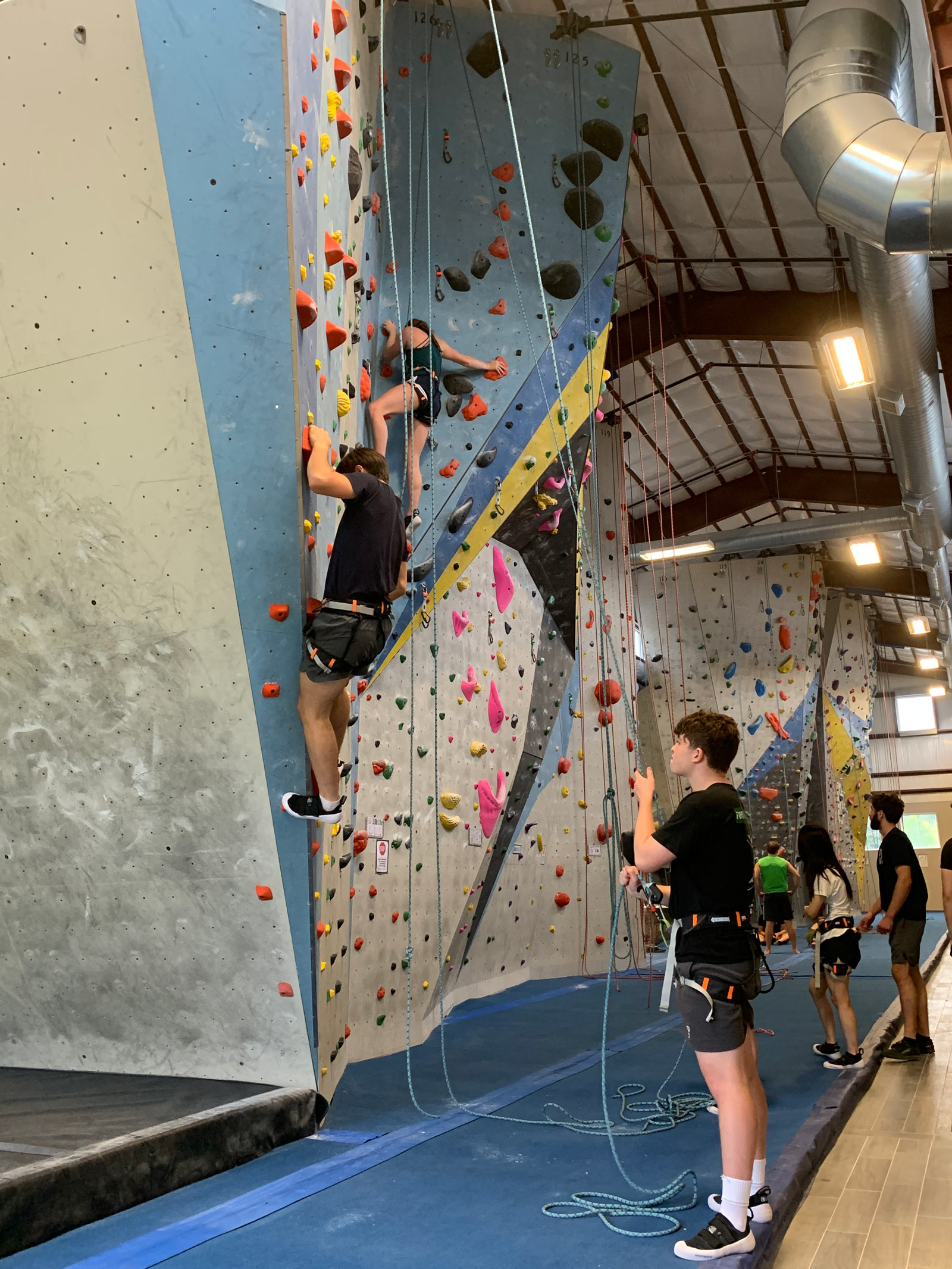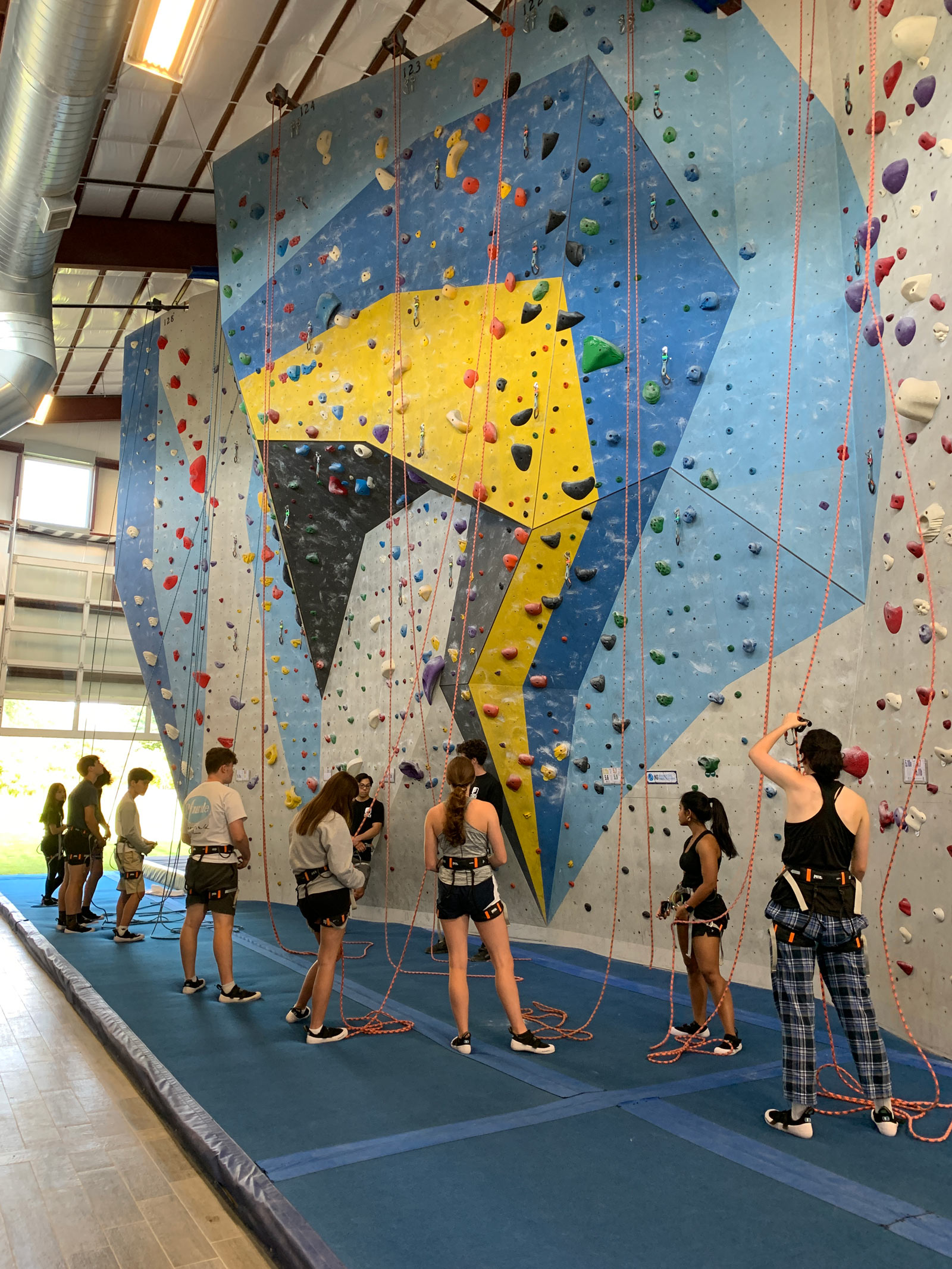One person ascends, carefully and wearing a harness, a roughly 50-foot wall. Below, a teammate holds the rope’s other end and systematically tightens or releases slack. It’s delicate choreography, based on trust, and the whole dance ensures the climber, high above, feels secure and able to take calculated risks without worrying they will plummet to the ground.
The symbolism of what goes on twice a week in Williston’s climbing and hiking afternoon program—support, trust, teamwork, reliance, cooperation—is almost too evident, too convenient. But the fact is, it’s true, and every Tuesday and Thursday, when the 10 students head to Central Rock Gym in Hadley for two hours of climbing, lead by a gym guide, they get a chance to put these skills to use.
The team balances these twice-weekly rock gym visits, during which they practice top-rope climbing and bouldering, with area hikes, which have taken them up Mt. Tom as well as to the Ashley Reservoir in Holyoke, Fort Hill in Amherst, and other local wilderness walks.
Started last Spring and now in its first full year, this year’s fall program is led by first-year biology and chemistry teacher Kaitlin Grant, a Western Massachusetts native returning to the area after seven years at Dublin School in New Hampshire, where she coached several seasons of the school’s “Outdoor Adventure” program.
Scaling Central Rock Gym’s 450,000 square feet of climbing area has had tangible benefits, both for the team and personally, says Livia Locke, a senior participating for her first time.
“It’s a big trust thing, making sure you’re not plummeting to the ground,” she said, outlining the dynamic between the climber, whose rope is connected from their harness up through an anchor at the top of the route, and the belayer, who stands at the bottom, managing the climber’s rope. All climbing and hiking participants are now certified in belaying.

“It’s a workout, for sure,” she added. “I don’t think people realize how much strength you build and how much strength it takes to keep going, especially for two hours. I have very strong arms right now.”
Locke said being paired up with someone different on the team every Tuesday and Thursday has contributed to a close-knit camaraderie built on safety and trust—something not necessarily inherent in many more traditional team sports.
“I love how close-knit everyone is,” Locke said. “I’ve become close with people I probably wouldn’t have become friends with otherwise.”
Coach Grant agrees. “They’ve gotten pretty close with other,” she said. “They’re all talking, they’re not stuck in their friend groups, and they’re very welcoming to new students.”
She added that because students have to belay each other, which she calls “the ultimate trust exercise,” she finds they are communicating better and more readily.
“They are coming out of their shells and talking to each other more, which carries over to our hikes, too.”
Grant has seen this dynamic in action, noticing that as climbers work up to more challenging levels, “they’ve learned how to read the wall.”
In addition to getting a sixth sense for assessing the route in front and above them, climbing and hiking has other less tangible benefits. Kat Martini, a senior on the team, enjoys the “focused, peaceful, and mindful” exercise inherent in being both on a quiet mountain trail and high up on the sheer rock wall.

Martini praised the Central Rock Gym instructors for pushing her and her teammates, urging them to tackle their insecurities.
“I literally conquered my fear of heights,” Martini said.
These abilities, both to assess the complexities of a route, to leap full force into something new, and to trust another person implicitly in the process, have deep roots for both Locke and Grant. Locke, a day student, grew up “always just walking around outside.” Her mom, Juliet, is currently in pursuit of climbing all 48 of the 4,000-foot peaks in New Hampshire, a quest she began three years ago. To date, she’s summited 12 of the “NH48” as they’re called and plans to finish within the next five years. Locke said that with enough training and time, she’d love to join her mom in an upcoming climb.
For Grant, the mountains and rivers of the Pioneer Valley sunk their claws into her parents long ago; they moved to the area for the whitewater kayaking. Her dad was a kayaking guide, and family trips centered around the sport. “Growing up,” she said, “we were always on the water in some way.”
Though the technical parts of the climbing and hiking program take the team members out of their normal routine, both in elevation and comfort, the excursions on non-climbing days, though they tend to be less physically demanding and more casual, are not without their excitement.
Grant recalled a hike in the early weeks of the season at nearby Nonotuck Park, during which the team encountered a bear.
“It was the closest bear I’d ever seen, it was crazy,” Grant said, noting that the bear was “eating berries about 10 feet from us.”
Ever ready to read the outdoors and react appropriately, Grant said the group, led by senior Emmett Gould, immediately acted the way it’s recommended when seeing a bear in the wild: act large, be loud, make your presence known.
“Emmett started it, and then everyone followed along,” Grant said.

